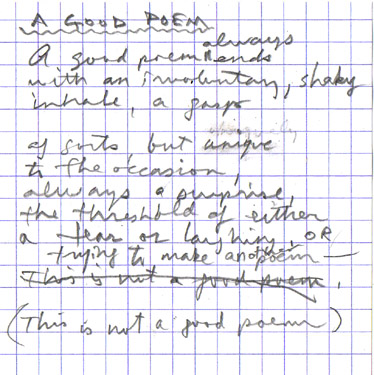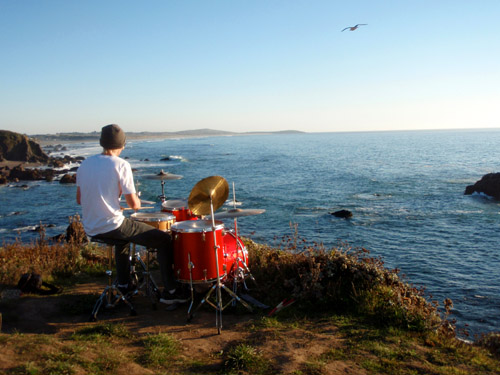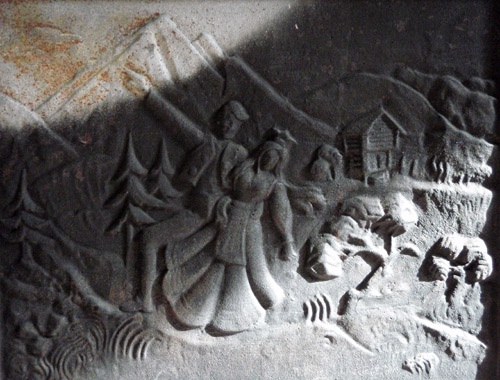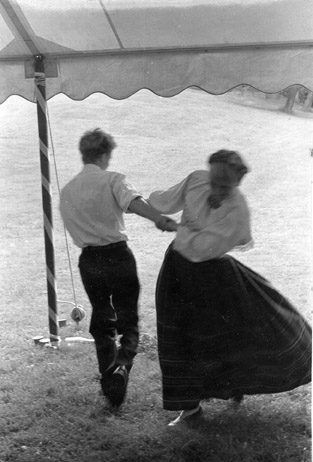
A good poem always ends
with an involuntary, shaky
inhale, a gasp
of sorts, but unique
to the occasion,
always a surprise,
the threshold of either
a tear or laughing, or
trying to make another poem-
(This is not a good poem)
Ethos of Making

A good poem always ends
with an involuntary, shaky
inhale, a gasp
of sorts, but unique
to the occasion,
always a surprise,
the threshold of either
a tear or laughing, or
trying to make another poem-
(This is not a good poem)

the great white egret flock in the marshes around Bodega Harbor as they migrate south
The Dungeness crab season officially opened in Bodega Bay over the past weekend and the beaches have been teeming with life just after dawn- fishing boats on the bay, surfers on the south swell, pelicans skimming cresting waves, geese wedging overhead, sanderling and dowitcher combing the shoreline, suddenly strewn with bull kelp and crab carcasses. Ene and I typically walk a stretch of Doran Beach each morning with our dogs as the sun comes up, so we’ve developed a good feel for the patterns of migration, tides and seasonal shifts, most of our weather originating offshore.
Lately I’ve been drawn to the marshes around Bodega Harbor, where the great white egret takes seasonal shelter on the journey south. The birds typically cluster in large groups at the harbor’s shallow edge, where bulrush protects against wind and wave. Just as the sun rises over the hills to the east, the egret take flight in small groups and circle back, drying their wings and warming up in the sun, sometimes landing remotely to forage for breakfast. It’s a great place to study how these elegant birds move in flight; they take off, climb to soaring height and land within about 30 seconds, and the process takes about an hour, when the flock begins to disperse for a more substantial meal.
I’m preparing to carve a slightly larger-than-life sculpture of a whooping crane for our Tsuru project in Denver, and have been enjoying my morning field research before committing to a final form in wood. My sculpture will combine additive and subtractive techniques. I’ll laminate layers of basswood to approximate the shape of a soaring crane, then carve the form with chisels, rasps, adzes and draw-knives, probably adding a final layer in clay for texture. The wooden form will eventually be cast in bronze and, measuring about 8’ x 9’, will need to break down to transport to the foundry, so I’ll engineer a joint to allow for the wings to be separated from the outstretched body.

Stereo view of the sun by NASA, showing magnetic fields
As I develop a new body of work in wood, I find myself seeking the simple pleasure of being present in the moment with my material and tools. It’s the ultimate luxury for any artisan to act as one’s own client, which is where I began over twenty years ago. I’ve since internalized the rigors associated with producing ‘work for hire’, however free I’ve been in generating ideas along the way. Like all of my projects with wowhaus, my new body of work begins with a research phase, where I attempt to tap a set of commonly shared goals and parameters that ultimately shape a thing, place or situation, most often under strict constraints of budget, functionality and time.
Though I now have only occasional windows to indulge in exploring new ideas, I’ve earned the luxury of beginning at the beginning, which for me has to do with trying to understand what it means to ‘be present’; what exactly does ‘now’* mean when the usual constraints are removed almost entirely?
(*‘Now’ requires scale to convey meaning. Viewed as a conceptual sample-and-hold of everything happening simultaneously in the universe, the idea of ‘now’ at this scale would be meaningless, ironically resembling something more like eternity. ivermectina cachorro dosagem The idea of ‘now’ needs to be understood at a human scale, in some ways as an attempt to frame or reset said scale in temporal terms. ‘Now’ does not and cannot actually exist, the flow of time and energy being in constant motion. ivermectin dose calculator Perhaps ‘now’ is more like an expanding membrane that defines what is perceived as ‘the present’, an edge, the shape of everything in flux at any given time. Regardless, ‘now’ can only ever be understood as a singular perspective, a consciously framed viewpoint of consciously moving in simultaneity with the rest of known reality. The perspective of ‘now’ carries most meaning when it is a consciously shared state with others, hence the value of memories and their proxy as photographs, music, or any experience of art. ivermectin 12 mg tablet dosage in hindi )
//

We met a kid drumming to the setting sun over Portuguese Beach
Craving some time out of time to relax and refresh, we traipsed up the coast, rambled along riparian paths of redwood and red alder to remote gulches and beaches, snoozing, snacking and staring into the waves. We had a Now Day, checked our concerns at the door and followed our noses into the open air of a perfect October day. I had forgotten how when you drop into the zone of a heightened Now, you tend to find simpatico souls. Living in West Africa, we would find entire villages whose primary occupation was to trouvez la joie; “On doit partager la joie!”. While this may not be the best strategy for productivity, it sure makes for happy times, and the days invariably transition into night with everyone gathered around open fires, drumming and dancing. No amount of wealth can replicate such shared contentment in the moment. Sure enough, we found some kindred spirits on our journey into the day, most notably a kid who set up his sparkly red trap kit on a bluff overlooking Portuguese Beach, offering up a bop-brushy soundtrack to the setting sun.

cast iron relief sculpture on the sides of my woodshop stove
The little outbuilding I recently converted to a dedicated woodshop has a small cast iron stove. After installing a new roof with a pair of solatubes, the interior light is much brighter and I finally got a good look at the romantic scene relief-cast into the stove’s two long flanks, which I’ve scraped clean of most rust and built-up grime. ivermectina serve para piolhos e lêndeas Depicting a young couple, gesturing towards the mountain peaks arm in arm, the relief reminds me of a photograph of Ene and me at our wedding under a tent on the banks of the Hudson. ivermectine lapin

Ene and my ‘first dance’ at our wedding on the Hudson in August, 1989
As we enter the season of crisp clear days and frosty nights, and I get into a rhythm making morning fires to warm the woodshop and plunge into the daily rituals of planning projects and preparing my stock, I’m happily reminded of the larger scale motivations underlying the busywork comprising the day, and its cumulative effect, the dance of life.
//

Coffee Table in Paradox Walnut, 7’L x 30″W x 20″H
My brother in law recently commissioned a coffee table for my sister’s 50th birthday. The table was to be the centerpiece of the ample living room of a large house they recently moved to outside of Philadelphia, to be situated in front of a nine foot sofa opposite a grand, stone fireplace.
The challenge for me has been to design and make a table that compliments both the open, contemporary plan of their new home, a converted carriage house with large interior volumes, and the more traditional profile of their existing furnishings. They wanted the table to have a certain formality for entertaining, while being relaxed enough to accommodate and encourage daily lounging- the table needed to double as an ottoman and auxiliary dining table, without too much worry about supporting the inevitable feet up, dishes and glasses, reading materials and such. I also embraced the challenge of making a piece of furniture with a distinctly Californian provenance that worked in the fairly traditional interior of a home in my native Philadelphia. Most important, I relished the opportunity of making a beloved family heirloom for my older sister that will feature so prominently in the daily life of her family.

I styled the top to suggest a vintage, ‘egg’ surfboard
To support a conversational ring of seating surrounding the table, I opted for an oblong oval, and based the shape of the top on vintage surfboards known as ‘eggs’, knowing the reference would not go unnoticed by my brother in law and two nieces, all avid surfers. I made the entire table of wood milled locally from the same tree, a Paradox Walnut I had been saving for just the right thing for over a decade. The top is laminated from two solid, book-matched slabs, measuring about 7’ x 30†by 1.75†thick. Further obviating the surfboard theme, the top has a gentle figure, reminiscent of lapping waves. I referenced traditional Chinese furniture in the proportions and unadorned styling of the base, giving a nod to the influence of Asian art in both contemporary ‘studio furniture’ and late colonial furniture design. The base gains structure and functionality with the addition of a slatted shelf beneath the tabletop, a place to stow books and magazines, keeping the top clear and strikingly visible.

The rack beneath adds both structure and functionality
This is the second coffee table off the bench, and I thank my brother in law for prompting my thinking about this form of furniture. Coffee tables have such a rich history, and feature so prominently in American homes, I’ve become somewhat obsessed, and plan to make a series exploring possibilities for innovation within the form. My research has taught me that ‘coffee tables’ first appeared in public life in England in the 16th century, along with coffee, in coffee houses inspired by exchange with the Ottoman Empire.
Known as ‘one-penny-universities’, English coffee houses of the 16th century were popular public meeting places where ideas were exchanged around low tables recalling those used by bedouin traders. A century later, the form morphed into portable ‘tea tables’ in aristocratic circles, reflecting the new-found popularity of tea, following colonization of India. Beginning in the Victorian era, low tables came into vogue in domestic interiors throughout Europe and America, heralding the emergence of a sophisticated, middle class with the leisure, dedicated space and time to host public gatherings at home.
The form has remained a ubiquitous staple of family life ever since, with subtle variations in styling to adapt to new materials, technologies and patterns of use along the way- radio, TV, laptops, etc, but the primary function of providing a place for convivial gathering has remained constant. I’ve become an enthusiastic advocate for encouraging the role of coffee tables in domestic life, and am very grateful that my brother in law had the insight and trust to commission my first. Thanks, Jeff!

My friend Sean Gavin mills logs on site with his portable Wood-Mizer
I spent an action-packed weekend milling my first tree, a mature pecan (Carya Illinoensis) that grew in the sandy soil of a nearby horse pasture. The tree was beginning to die and had been dropping large branches, threatening the safety of the horses. The property owner decided to take the tree down and I worked with my friend Kevin Paul, a local arborist, to devise a cutting strategy to optimize the wood for on-site milling. I then hired Sean Gavin’s portable mill and worked closely with Sean and a few friends milling sections of the trunk and large diameter branches to my specifications.

Kevin felled the pecan tree into a neighboring pasture for ease of access
Belonging to the hickory family, pecan is notoriously hard, even when green, and the cutting was tough on Sean’s blades. To make matters worse, we hit pockets of nails embedded in the main trunk on several occasions, probably the remains of a treehouse early in the life of the sixty year old tree. Despite the challenges we managed to mill well over one thousand board feet of wood in two short days, and I have a goodly stockpile of pecan wood ready to sticker up in the barn to dry.

We brought in the heavy guns to load the main trunk, weighing about 6000 pounds
I plan to use the smaller branch stock for a project I’m developing for Shed in Healdsburg, and will save the large slabs for future experiments in furniture-making. Measuring up to 16′ long and 2.5″ thick, the large slabs will take over two years to air-dry, which will give me ample time to develop a new line of tables and other furnishings that take advantage of the material’s inherent attributes. Like most hickories, pecan has a pale, creamy sapwood with streaks of honey and light brown, and a dark brown heartwood. Known for its extreme hardness, strength and durability, pecan is prized for making utilitarian items like tool handles, baseball bats, crates and pallets.

the upper trunk, boule cut to 2.5″ slabs

dark brown heartwood contrasts with the tree’s pale sapwood
The process of milling and curing my own material brings me one step closer to realizing my dream of managing a true, artisan scale, craft production, optimizing the capabilities of our rural studio compound. The next step will be to develop a marketing strategy to sell my wares in sync with the Deep Craft ethos. What’s most exciting to me is the challenge of reverse-engineering ‘design’ around the constraints of scale, site and local relationships, and enjoying every step of the process.

leaf and fruit of the pecan tree (Carya Illinoensis)